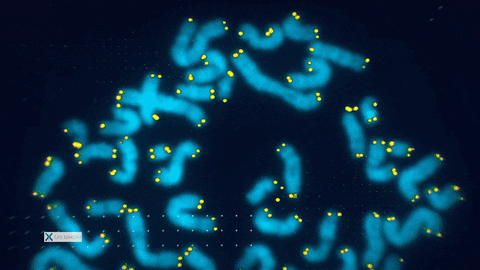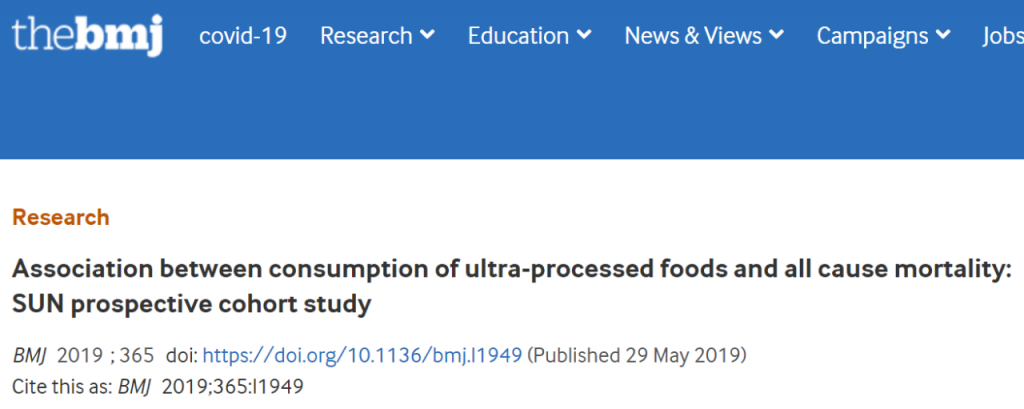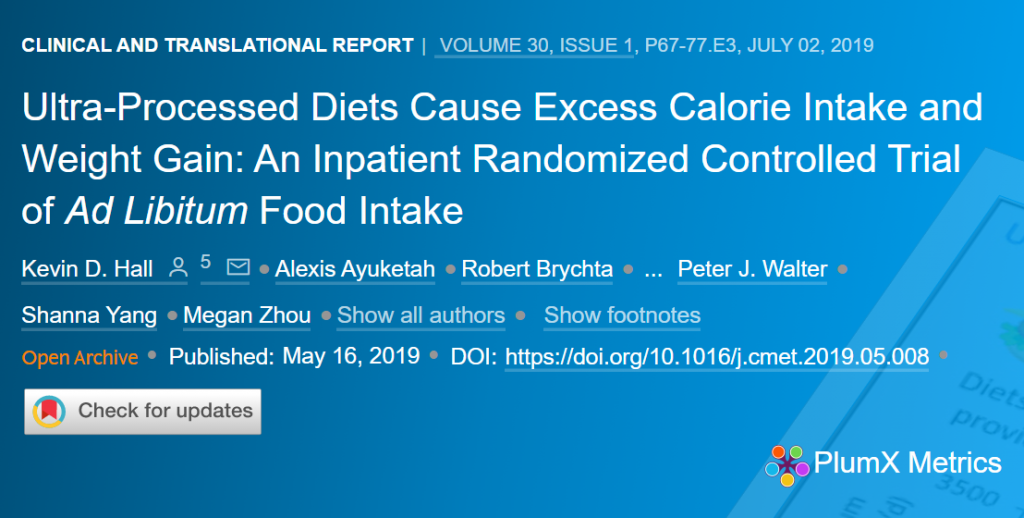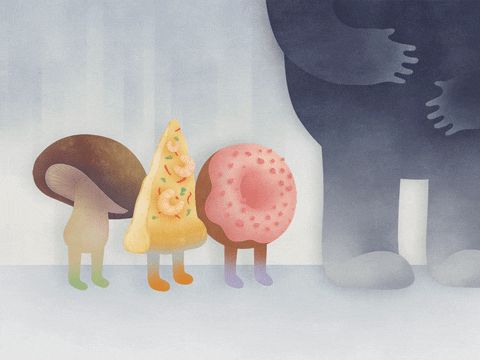
Instant noodles, biscuits, candies, pastries, ham sausage, instant soup…… What these foods have in common is that in addition to having a good taste and convenient eating, they are all super processed foods.
Studies have shown that daily consumption of ultra-processed foods not only leads to obesity, but also accelerates the
shortening of chromosomal telomeres and shortens life span in the long term.

What exactly is “ultra processed food”? Is ultra-processed food = junk food?
Long-term effects: accelerated aging, reduced life
A Spanish study published in the American Journal of
Clinical Nutrition shows that excessive intake of ultra-processed foods will shorten the DNA telomere chain at the end of the chromosome, and short telomeres are a sign of biological aging at the cellular level.

Telomeres are called “biological clocks”
The researchers analyzed 886 participants who provided DNA samples in 2008, aged between 57 and 91.
Since then, every two years, a large amount of basic information such as the lifestyle and health of the participants will be counted, and their eating habits will be investigated in detail.

According to the intake of ultra-processed food from low to high, the subjects were divided into four groups: <2 servings/day, 2~2.5 servings/day, 2.5~3 servings/day, >3 servings/day.
The results showed that compared with the “<2 servings/day” group, the probability of shortening telomeres in the other three groups increased by 29%, 40%, and 82%, respectively.
Researchers emphasize that eating ultra-processed foods is not the only factor that accelerates the shortening of telomeres.

In life, the above-mentioned groups of people also have lower levels of physical activity, watch TV while eating snacks, use the computer for a long time, and have a higher proportion of living alone.
Another large-scale study published in the British Medical
Journal pointed out that ultra-processed diets are associated with the risk of premature death.

Researchers from the University of Navarre in Spain
monitored the eating habits and physical conditions of nearly 20,000 people aged 20 to 91 between 1999 and 2014.
The results found that compared with those who ate less than 2 servings of ultra-processed food a day, those who ate more than 3 servings had a 62% higher risk of all-cause death. For every extra serving of ultra-processed food, the risk of death from all causes will increase by 18%.
Short-term impact: significant increase in fat
Ultra-processed food seems to have a kind of “magic”, its taste, color or smell will induce people to eat faster. The gastrointestinal tract does not have enough time to send a “satisfaction signal” to the brain, so it will eat a lot unconsciously.
A joint study between the United States and Singapore revealed the direct relationship between short-term consumption of ultra-processed foods and obesity.
Experiments have found that a super-processed diet for two weeks can increase a person’s weight by about 1 kg, while an unprocessed diet can reduce about 1 kg. Among them, the ultra-processed food group consumed an average of 508 kilocalories per day.
The reason why ultra-processed foods cause health problems is related to their high levels of sugar, salt, saturated fatty acids, and calories. Moreover, a lot of dietary fiber and vitamins are lost during processing.
This makes people who eat ultra-processed foods prone to become obese, and the risk of cardiovascular disease, cancer, and irritable bowel syndrome is significantly increased.
How to distinguish ultra-processed food?
The packaging of some ultra-processed foods makes it difficult for consumers to identify: the packaging is printed with pictures representing fresh and healthy fruits and vegetables; slogans that emphasize energy and vitality are selected; they are marked as “no sugar” but contain sweeteners, maltitol……
All these make ultra-processed foods look “very healthy”.

Ultra-processed food is synonymous with junk food. According to the international food classification standard “NOVA”, food can be divided into four categories according to the degree of processing:
No or almost no processed foods: such as fruits, vegetables, meat, eggs, milk, bacteria and algae, drinking water, etc.;
Cooking ingredients processed by grinding and refining methods: such as salt, sugar, oil, etc.;
Processed foods are often made from the first two categories: such as canned vegetables, fruits, fish, sweetened dried fruits, salt-cured meat, freshly baked bread, etc.;
Ultra-processed foods: such as meat products with added preservatives, instant noodles, butter cakes, biscuits, packaged breads, energy bars, etc.
Ultra-processed foods also use processes that are not used in ordinary cooking, such as hydrogenation, hydrolysis, extrusion, and shaping.

Therefore, compared with processed foods, ultra-processed foods often add hydrogenated vegetable oils, modified starches, colors, artificial flavors, emulsifiers, preservatives, sweeteners…
Four characteristics help you identify ultra-processed foods quickly:
1. The content of seasonings such as sugar, salt and oil is higher.
2. Contains added ingredients such as preservatives and has a longer shelf life.
3. Full packaging.
4. Can’t see the original appearance of the ingredients.
4 changes, eat less ultra-processed food
According to a study by the University of Navarre in Spain, the supply and consumption of ultra-processed foods have increased significantly in almost all countries in the past 20 years.
“High-calorie” and “low-nutrition” ultra-processed foods have become part of most people’s daily diet. If you have habitually consumed ultra-processed foods, how should you change?
1. Balanced nutrition when dining out
When dining in a restaurant, you can order more steamed, boiled, and fried vegetables instead of fried foods, and pay attention to balanced nutrition.

It is recommended to eat 12 kinds of food every day.
Specifically, it is recommended to eat 3 kinds of cereals, potatoes, and miscellaneous beans every day; 4 kinds of vegetables and fruits; 3 kinds of livestock, poultry, fish, and eggs; 2 kinds of milk, soybeans, and nuts.
If you want a variety of food, you need to reduce the amount of each staple food and dish, and achieve a combination of thickness, meat and vegetables, and a variety of colors.
Coarse and fine matching: rice can be matched with coarse grains such as millet, corn, buckwheat, red beans, etc.
Meat and vegetable combinations: Stir-fried shredded pork with celery, stir-fried shrimp with broccoli, crucian tofu soup, chicken stewed with mushrooms, etc. are typical dishes with meat and vegetables.
Variety of colors: foods of different colors provide different nutrients, such as carrots rich in beta carotene, purple cabbage rich in anthocyanins, and tomatoes rich in lycopene. These biologically active ingredients can participate in the body’s anti-oxidation, anti-aging and anti-cancer effects All help.
2. learn to read the ingredient list
According to the national regulations on food labeling, the order of ingredients in the ingredient list is related to the amount of addition. The more ingredients, the higher the order.
Take processed coarse grain foods as an example. If bran and whole wheat flour are in the bottom of the list of ingredients, this is a food with very little dietary fiber and cannot be regarded as a true whole grain food.
Some commercially available “coarse grain products” are actually refined processed foods, and the main ingredient is refined flour.
In addition, the taste and selling of real crude grains are different. The merchants will add a lot of vegetable oil to soften the fiber, and add sugar and salt to improve the taste. Before buying, it should be identified according to the ingredient list.
If you must buy ultra-processed foods, it is recommended to choose foods with simple ingredients. Try not to choose foods with a calorie value of about 2,000 kJ per 100 grams.
3. Snacks, choose fresh fruits and vegetables
If you have developed the habit of eating ultra-processed foods, you can eat less every day like quitting smoking. Try to substitute fresh natural foods and reduce the consumption of refined processed foods gradually.

Fresh natural foods are rich in trace elements and plant actives, which are more beneficial to health.
It should be noted that certain processing technologies and necessary additives are tools to ensure food safety. Consumers need not blindly resist, but should pay attention to the degree of food processing. For example, pures milk, plain yogurt, plain nuts, etc. are good.
4. Cook more for one person
The advantage of ultra-processed food is that it can be eaten after opening the package or heating it for a while. It has a long shelf life and is convenient for storage. You can buy many stocks at home at once.
These seem to be “appropriate” for young people living fast-paced or living alone. But over time and the accumulation of intake, negative effects will appear gradually.

When cooking by yourself, you should add as little oil, sugar and salt as possible, and try to replace high-fat or high-sodium artificial seasonings with vinegar, lemon juice, garlic and natural flavors. The right amount of vinegar can enhance the saltiness, and the onion, ginger and garlic can enhance the flavor.
In addition, spices such as pepper, cinnamon, star anise, chili, etc. not only make the dishes mellow and sweet, but also have anti-inflammatory effects. They are also good substitutes for artificial seasonings.
Comments